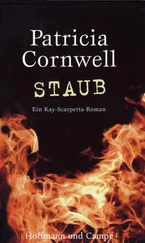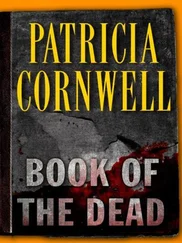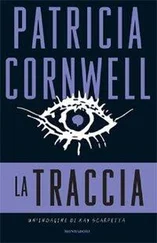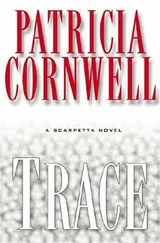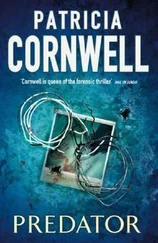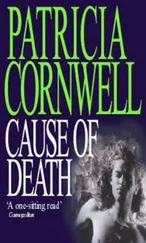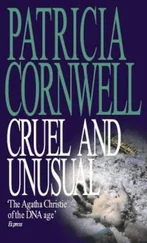I notice from Colin’s measurements and descriptions that the wound to Gloria’s neck begins behind her left ear and travels down in one clean incision, under the chin, below the right earlobe, consistent with her having her throat cut from behind. If she didn’t see it coming and her carotid was severed, that would explain the lack of defensive injuries Colin mentioned, but it raises more questions than it answers. Next I notice another photograph of her on the bed, a close-up taken from the foot of it. Blood spatters are on the tops of her feet, and the soles of them are bloody, which doesn’t seem possible if she was lying down when she was cut and stabbed. But it’s hard to say. There was so much blood everywhere, and I try to imagine an assailant cutting Mrs. Jordan’s throat from behind if she was lying down, sound asleep, drugged out on clonazepam.
I follow blood that is streaked, smeared, pooled, stepped in, and splashed on the stairs, and then the arterial pattern that may have been from the slashing of the knife, perhaps to the neck, perhaps Gloria Jordan’s neck, the spatter arching in rhythm to the beating of a heart that was about to quit. But whose heart, and which direction was the person heading, up or down, in or out? Crime scene investigators, even good ones like Sammy Chang, can’t swab every blood drop or streak or mop up every pool and puddle at a scene, and the labs couldn’t possibly analyze all of it.
Down the stairs to the landing at the bottom, and I pause in the area near the entryway and front door where Brenda collapsed as I try to come up with an explanation for why her blood would have been transferred to the nightgown of her mother, who supposedly died in bed. I look for any evidence that efforts were made to clean up blood in the foyer, on the stairs, in the hallway, or anywhere in the house, but I see nothing that hints of it, and there is nothing to suggest it in any of the reports I’ve seen. I continue going back to the area of the entryway, to Brenda’s body, a sight that must have horrified police when they arrived at the house after the next-door neighbor discovered the broken glass in the kitchen door and called 911.
No normal person likes to look at dead children, and it’s a temptation not to look closely enough. The flooring in the area of the entryway is a chaotic pattern of drips and spatters cast off by a weapon, and smears and puddles, and bloody prints left by footwear and also marks that appear to have been made by bare feet. Toe prints and a heel that are too large for a child’s, and I pick up the SpongeBob pajamas again. They have footies. The marks left by bare feet could not have been left by Brenda when she was fleeing downstairs toward the front of the house and the door, and I find myself back to the same conundrum, the cut, which is significant, on her mother’s left hand.
Colin speculates Mrs. Jordan sliced open her thumb while pruning in her garden, and I follow the thread of this theory through photographs, returning to the sunporch and the garden in back. I revisit the round drops of dried blood, approximately eighteen inches apart on terra-cotta tile and flagstone and foliage, Mrs. Jordan’s blood, believed to be unrelated to the case and excluded from evidence at the trial. If what Colin suggests is correct, and I don’t think it is, she must have injured herself almost immediately after she began pruning. But there’s no tool anywhere in any of the pictures I review, not a cut branch or side shoot or sucker in sight, the garden bleak and in need of a winter cleanup it never got.
When Marino questioned Lenny Casper, the former next-door neighbor who happened to notice Mrs. Jordan in her garden the Saturday afternoon of January 5, Casper made no mention of her appearing to have hurt herself. Maybe he didn’t notice, but most people taking their dog out or looking through a window might be aware of someone hurrying back into the house, dripping blood. A casual observation by a neighbor and drops of Gloria Jordan’s blood that didn’t make sense in the context of such gory homicides led to the conclusion that she cut her thumb earlier in the day. She returned to the house, forgot to clean up the sunporch and the hallway near the guest bath, and didn’t bandage her injury or let her physician husband tend to it when he arrived home from the men’s shelter. I just don’t believe it.
According to her toxicology report, when Mrs. Jordan died she had alcohol and clonazepam on board, higher blood levels than her husband’s, and she was taking the antidepressant sertaline. After the murders, these prescription drugs were collected from the master bathroom, from what appears to be her side of the sink, and I look at them again in their evidence bag, noticing a detail that eluded me earlier.
“You want to help me with something?” I ask Mandy, who is observing everything I do with her cobalt blue stare.
“You bet.” She’s already out of her chair.
“The Barrie Lou Rivers case file? I believe it’s electronic, not printed, because her death occurred after the office became paperless.”
“Want me to print it?” she asks.
“Not necessary. But I’m interested in a document, if you can find it in her file.”
“Can you wait one minute so I can get my laptop?”
“I’ll stand in the hallway.” I step outside the conference room.
Mandy O’Toole returns from the histology lab with a laptop and begins a search of Barrie Lou Rivers’s records while I search Lola Daggette’s clothing for anything that might have been missed.
I examine the Windbreaker, the blue turtleneck and tan corduroys that she was washing in her shower, an incriminating act that was the sole basis for her being charged with multiple counts of first-degree murder and sentenced to death. Much of the blood was washed away, only traces of a pattern left, areas of dark discoloration on the thighs of the pants, and drips and smears on the cuffs and on the front of the Windbreaker and its sleeves. Lola would have had blood on her shoes, and my thoughts keep going back to that.
“Got her file. Tox and other lab reports, autopsy records,” Mandy says, sitting in the chair by the window, the computer in her lap. “What are you looking for, exactly?”
“Something you might not have but Jaime Berger did. A one-page document included with the autopsy protocol and tox reports,” I reply. “A chain-of-custody form from the GPFW relating to the execution drugs. The prescription was filled but never used because Barrie Lou Rivers died before they could execute her. Just a strange piece of paper that doesn’t belong with the autopsy record but somehow ended up in there.”
“My favorite thing,” she says. “Details that aren’t supposed to be included. But they are.”
As I continue looking at Lola Daggette’s clothing, I think about what the victims had on when they died and how much blood there was. The crazed trail of footwear prints on the black-and-white checkered kitchen tile and the fir wood floor indicate that the killer was tracking blood throughout the house or someone was or more than one person was. Not all of the tread patterns look the same. Contamination by people disrupting the crime scene after the police got there, or did Dawn Kincaid have a partner in her hideous crimes?
It wasn’t Lola. Had she been walking around the Jordans’ house that early morning, her shoes would have been bloody. Yet she wasn’t washing shoes in the shower when the volunteer healthcare worker walked in. She wasn’t washing her underwear or socks. She was never examined for injuries, such as scratches, and it wasn’t her DNA or fingerprints recovered from the victims’ bodies or the scene, and it’s tragic no one paid attention to these facts. Dawn Kincaid’s DNA but her fingerprints aren’t a match, and I remember what Kathleen Lawler said about giving her children away. As if she had more than one.
Читать дальше

